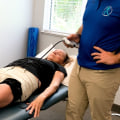Blood flow restriction training uses metabolically more demanding sets & repetitions with a much shorter rest period between (typically 30-45 seconds). Try to do 15 to 30 reps for 4 sets with only 30 seconds of rest between each set. Concentrate as you squeeze each repetition and feel the movements that work your muscles. You usually do between 3 and 5 exercises during a session.
And work on your arms or legs during a session, but not both. Remember that these are high-volume sets together; 30-second breaks between sets and 1-2 minute breaks between exercises. Research is starting to show the overwhelmingly positive effects of blood flow restriction training, especially in clinical settings aimed at rehabilitation. Traditionally, BFR involves the use of a specialized inflatable cuff, known as a KAATSU device, to restrict venous blood flow.
Basically, arteries can still send oxygen-rich blood to muscles during bfr training, but venous and oxygen-depleted blood flow is restricted. Due to the low loads used with the restriction of blood flow and the limited muscle damage that occurs, athletes can benefit from decreased training loads, while obtaining a physiological stimulus for muscle adaptation. This approach may be beneficial in identifying people at risk of harmful complications during blood flow restriction, however, general contraindications and precautions should be considered. It is safer to use a specific pressure for each individual patient, because different pressures obstruct the amount of blood flow for all individuals under the same conditions.
The idea is to restrict some, but not all, of the blood flow to the muscle while lifting weights. When implementing blood flow restriction, the cuff width should be appropriate and the restrictive pressure should be specific to each individual limb. By restricting the veins and not the arteries, blood can continue to accumulate in an active muscle and remains trapped there. It is important to note that traditional endurance exercise already results in occlusion of blood vessels even during contractions of moderate strength.
The amount of pressure needed to occlude blood flow in the limb depends on the size of the limb, the underlying soft tissue, the width of the cuff, and the device used. Research data clearly demonstrate that low-load blood flow restriction training can improve physical performance markers in athletes who are already well-trained. To train with blood flow restriction, you will wear a bracelet or tourniquet system specially designed for this type of training. This is important to keep in mind; if the blood flow restriction stimulus or prescribed training does not follow scientific logic, suboptimal training responses could occur (.



Leave Reply